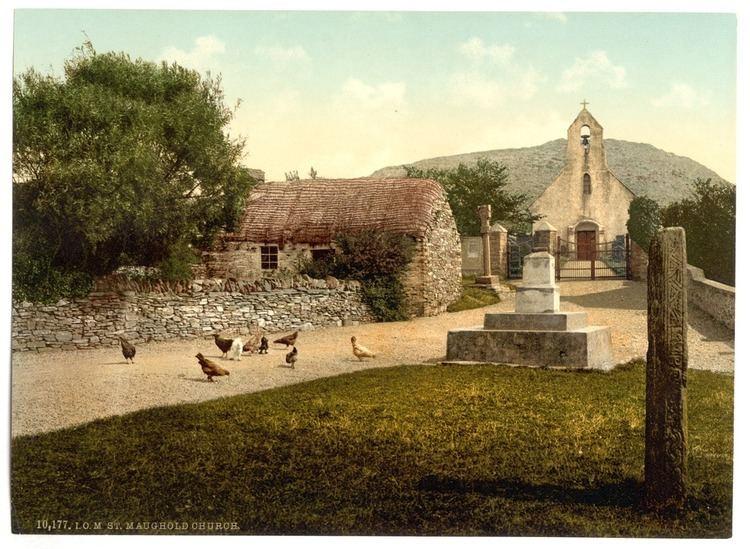25th April - St Maughold, patron saint of the Isle of Man
Anne Newman · Tuesday, 23 April 2019 updated 2024

St Maughold has a number of variations to his name: one is Machalus and another is MacCaille.
Tradition states that he was an Irish prince and a pirate captain who was converted to Christianity. It is said that St Patrick baptised him and as a penance for his crimes, Patrick ordered him to abandon himself to God on the sea in a coracle padlocked onto a chain, the key being thrown into the River Boyne. He was instructed not to loose the chain until the key had been found and returned to him.
Maughold obeyed, and he was washed up in a bay on the Isle of Man, where two Christian missionaries, Conindrus and Romulus, had their settlement. Previously that day, they had caught a fish, in which was the key that could unlock Maughold's manacles, so he shared the holy men's abode and became their servant. They taught him letters, and eventually he was ordained a priest.
Another version of this is that stranded on Maughold Head, (Isle of Man by Drone photo) , he was shown hospitality by the Bishop of the Island and ultimarely became a priest. On the eve of his ordination the cook brought in a key which he had found in the belly of a fish which he had been dressing for their dinner. This was, of course, the key which was destined to release Maughold of his chain.
On the brow of the hill not far away there is a holy well. A ledge of rock nearby is called St Maughold’s “chair”. A favourite devotion of pilgrims has been to sit on the ledge, invoke the saint’s help, drink the water of the well, which is said to prevent poison. He was eventually chosen by the local people as their bishop. His feast day is 25th April, died c. 488 AD.
| He entered into a cave in the mountains there and lived a life of austerity and piety. There is still a church and graveyard dedicated to the saint at the place near where he landed. |  |
Maughold, St. Patrick and a dead man hoax
One local legend relates that Maughold tried to make a fool out of Patrick. Maughold had, according to this story, placed a living man in a shroud. He then called for Patrick to try to revive the allegedly dead man. Patrick came, placed a hand on the shroud, and left. When Maughold and his friends opened the shroud, they found the man had died in the interim.
One of Maughold's friends, a fellow named Connor, went over to Patrick's camp and apologized to him. Patrick returned and baptized all of the men assembled. He then blessed the man who had died, who immediately returned to life, and was also baptized. Patrick then criticized Maughold, saying he should have been helping his men into leading good lives, and told him he must make up for his evil.
His name is linked to the only pre-Norse monastic foundation in the north-eastern portion of the island, east of Ramsey; from this comes Maughold Head, the village of Maughold, St Maughold's Well, and St Maughold's Cross, an 8-foot standing-stone cross with biblical scenes and St. Maughold's Chair.
St Maughold’s Well
A path on the north side of Maughold Head leads down to an ancient spring within a rocky crevice said to have been used by Saint Maughold and called Çhibbyr Maghal (St.Maughold's Well). It is a slow running spring with a small bowl shaped hollow carved by centuries of dripping water. It is framed by stone slabs, including a space where you can sit.
The well was principally said to have been visited by local people on Easter Day and the second Sunday in August. Offerings, including little crosses made of straw, were thrown into the water at the moment when the sun was seen to be rising out of the sea. The well was also said to have been "dressed," on every 12th August. The water was taken as a cure and seen as providing protection.
The village of Maughold lies to the west of the headland. It was the site of a 5th century Celtic monastery. Maughold churchyard has within it the remains of three ancient Keeills (early Christian chapels dating from before 12th century). The present church dates from around the 11th to 12th century. A large number of Celtic Crosses and Norse carvings dating from the 6th to 13th centuries are housed in a collection within the churchyard. There was also once an ancient pre-historic tomb on the site. A journey to Maughold Head and St Maughold’s Well is complimented by visiting Maughold churchyard.
The Chronicles of Man, written by the monks of Rushen Abbey on the island, and now in the British Museum, records how once a Viking, after a battle at Ramsey, planned to rob the church, but that night was visited by St.Maughold, who struck him three times on his chest with his staff. He died from a heart attack, and his companions sailed away hurriedly. The ancient arms of the diocese used to portray a bishop standing in a boat, with a star and key above him.
---oOo---
Below is a video of the ladies of Maughold carving turnips for 31st October's celebration of the original New Year's Eve - Oie Houney.





